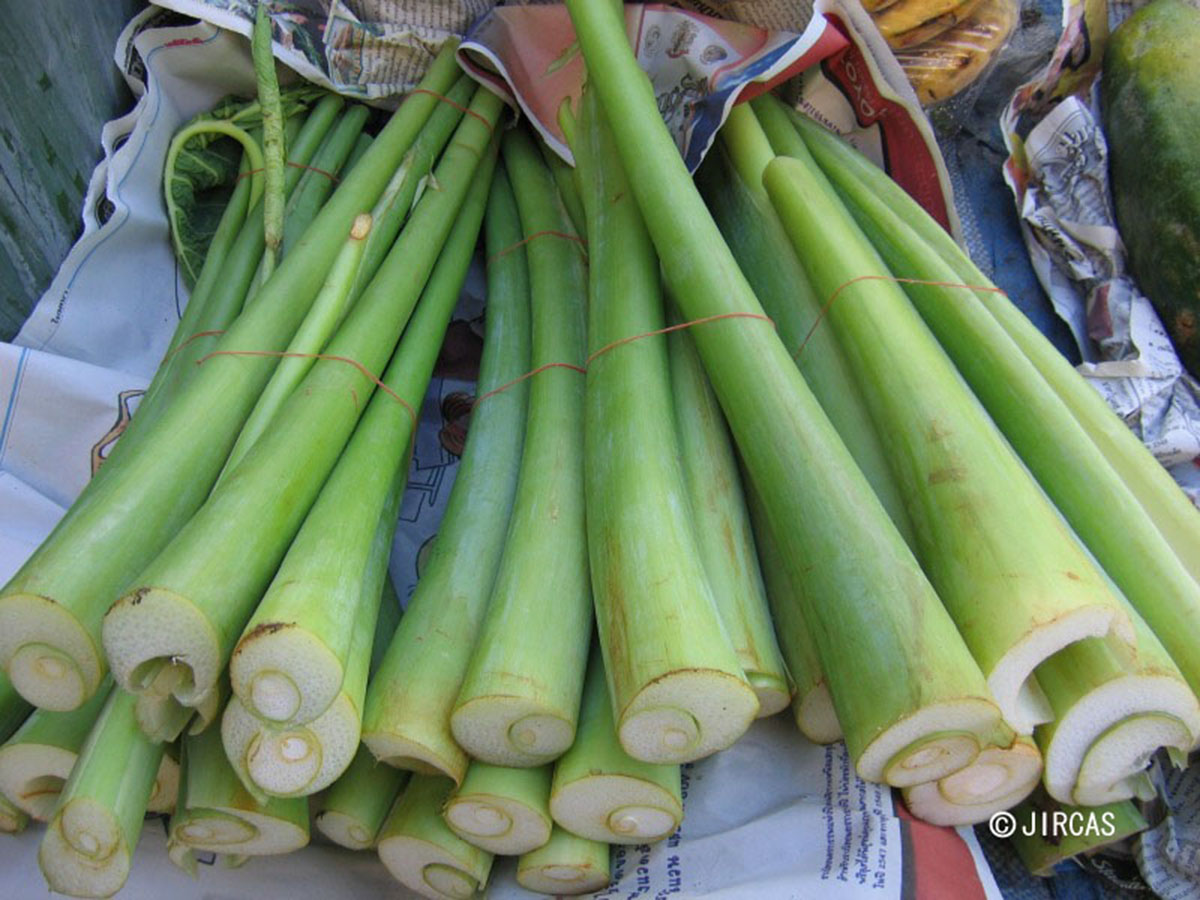ເລກລຳດັບທີ: 608
ລະດັບການຮວບຮວມຂໍ້ມູນ: ຂໍ້ມູນພື້ນຖານ
ປັບປູງຄັ້ງລ່າສຸດ: N/A
ຜັກກ້ານທູນ
Giant Elephant Ear
Leucocasia gigantea (Blume) Schott
ພືດ
ພືດລົ້ມລຸກ
ຜັກ ແລະ ພືດລົ້ມລຸກ
×
ຊື່ທ້ອງຖີ່ນ:
Eng: Indian taro
Vietnamese: dọc mùng
ຊື່ພ້ອງ
:
Arisaema fouyou H.Lév.
Caladium giganteum Blume
Colocasia prunipes K.Koch & C.D.Bouché
Leucocasia gigantea (Blume) Schott
Caladium giganteum Blume
Colocasia prunipes K.Koch & C.D.Bouché
Leucocasia gigantea (Blume) Schott
ຊື່ສະກຸນ:
Araceae
ຊະນິດໃກ້ຄຽງ:
ບັນຍາຍລັກສະນະທາງພືດສາດ:
ເປັນພືດລົ້ມລຸກຫລາຍປີ, ມີຂະໜາດໃຫຍ່ ທັງຕົ້ນ ແລະ ໃບ ສູງປະມານ 3 ມ, ລຳຕົ້ນເທິງໜ້າດິນອວບ. ໃບດ່ຽວຂະໜາດໃຫຍ່, ກ້ານໃບສີຂຽວຈາງ, ມີຝຸ່ນອອກສີຟ້າແກມຂຽວຢ່າງໂດດເດັ່ນ, ກ້ານຍາວເຖິງ 2.5 ມ, ແຜ່ນໃບຮູບຫົວໃຈ, ກ້ວາງ 17-150 ຊມ, ຍາວ 25-250 ຊມ, ເປັນແຜ່ນບາງຄືເຈ້ຍ, ຖານໃບຮູບຫົວໃຈ, ກ້ານໃບຈັບຢູ່ກາງໃບ, ຂອບໃບເປັນຄື້ນ, ປາຍຮຽວແຫຼມ; ດອກ ອອກເປັນຊໍ່ຕາມແນວແກນກາງຂອງໃບ, ກ້ານຊໍ່ດອກເປັນທໍ່ກົມ, ຍາວ 30-80 ຊມ, ໃບຊ້ອນຊໍ່ດອກສີຂາວແກມສີຂຽວຂະໜາດ 12-24 ຊມ, ດອກແຍກເພດຢູ່ໃນຊໍ່ດຽວກັນ, ເຂດດອກເພດແມ່ສີຂາວ ຫຼື ສີຄີມຢູ່ທາງດ້ານລຸ່ມ, ມີເຂດທີ່ເປັນໝັນ 3-4 ຊມ, ເຂດດອກເພດຜູ້ ຍາວ 5-14 ຊມ. ໝາກແບບມີເນື້ອ, ຮູບເກືອບກົມ ເມື່ອໝາກແກ່ຈະເປັນສີແດງ ມີແກ່ນຈຳນວນຫຼາຍ.
ນິເວດວິທະຍາ
ເຂດກະຈາຍພັນທົ່ວໂລກ:
N/A
ເຂດກະຈາຍພັນໃນລາວ
:
ເຂດກະຈາຍພັນຕາມພູມສັນຖານ
:
ສະເພາະຖິ່ນໃນລາວ:
N/A
ຮຸກຮານ
:
N/A
ສະຖານະພາບການອະນູຮັກ IUCN
:
N/A
ສະຖານະພາບການອະນຸຮັກແຫ່ງຊາດລາວ
:
N/A
ການນຳໃຊ້
ປະເພດການນຳໃຊ້:
ອາຫານ
ພືດເປັນຢາ
ພືດເປັນຢາ
ບັນຍາຍການນຳໃຊ້:
ກ້ານທູນແມ່ນສ່ວນກ້ານຂອງໃບທູນທີ່ເຫັນວ່າຂາຍຕາມທ້ອງຕະຫຼາດ ເພີ່ນຈະຕັດເອົາແຕ່ກ້ານ ສ່ວນໃບແມ່ນເອົາເປັນເຮັດຫໍ່ມົກ ແລະ ອື່ນໆ, ເພີ່ນຈະລອກເອົາເປືອກສີຂຽວອອກເອົາແຕ່ອັນສີຂາວມາກີນເປັນຜັກກັບແຈ່ວເຊັ່ນ ແຈ່ວປາ, ແຈ່ວໜໍ່ໄມ້ສົ້ມ ແລະ ກັບໝ່ຽງຕ່າງໆ ສ່ວນຫຼາຍມັກຈະເຫັນຫຼາຍໃນລະດູຝົນເພື່ອວ່າລະດູຝົນມັນຈະເລີນເຕີບໂຕໄດ້ດີເພາະວ່າມັນມັກນ້ຳ.
ປິ່ນປົວພະຍາດ: ຊ່ວຍດູດນ້ຳໜອງຢູ່ໃນຝີ ສ່ວນທີ່ໃຊ້: ກ້ານໃບ ວິທີການນຳໃຊ້: ນຳເອົາກ້ານອ່ອນມາຕຳໃຫ້ມຸ່ນແລ້ວເອົານ້ຳມັນພືດໃສ່ໃຫ້ພໍມື່ນໆ ຫຼັງຈາກນັ້ນເອົາມາຫໍ່ໃສ່ຕອງແລ້ວນຳໄປໝົກໄຟໃຫ້ຮ້ອນ ແລ້ວນຳມາໂພະໃສ່ບໍລິເວນທີ່ເປັນຝີ ເພາະຈະຊ່ວຍດູດນ້ຳໜອງອອກໄດ້.
ການປູກຂະຫຍາຍພັນ: ທູນເປັນພືດທີ່ປູກງ່າຍເປັນພືດທີ່ມັກດິນຜຸ່ຍມີເສດຊາກພືດທັບຖົມ ແລະ ມັກຢູ່ບ່ອນຊຸ່ມ, ຂະຫຍາຍພັນໄດ້ສອງວິທີຄື: ກ້າແກ່ນ ແລະ ແຍກເຫງົ້າ.
ການປູກ ການລ້ຽງ:
N/A
ລະດູການເກັບກູ້:
ການຕະຫຼາດ ແລະ ຕ່ອງໂສ້ມູນຄ່າ:
N/A
ການຄຸ້ມຄອງຈັດການ
N/A
ໂພຊະນາການ
ຄຸນຄ່າທາງໂພຊະນາການ:
ບັນຍາຍຄຸນຄ່າທາງໂພຊະນາການ:
N/A
| ສານອາຫານ | /100g | ໝາຍເຫດ |
|---|---|---|
| ໂປຣຕີນ | N/A | N/A |
| ຄາໂບໄຮເດຣດ | N/A | N/A |
| ໄຂມັນ | N/A | N/A |
| ວິຕາມິນ | N/A | N/A |
| ແຮ່ທາດ | N/A | N/A |
| ເສັ້ນໄຍ | N/A | N/A |
ອ້າງອິງ
ເຄດິດຮູບພາບ:
ອ້າງອິງ:
Plant Resources of Southeast Asia. http://proseanet.org/
Flora of China Editorial Committee. 2010. Flora of China (Acoraceae through Cyperaceae). 23: 1–515. In C. Y. Wu, P. H. Raven & D. Y. Hong (eds.) Fl. China. Science Press & Missouri Botanical Garden Press, Beijing & St. Louis.
http://www.efloras.org/florataxon.aspx?flora_id=2&taxon_id=200027265
Boyce, P.C., Sookchaloem, D., Hetterscheid, W.L.A., Gusman, G., Jacobsen, N., Idei, T. & Nguyen, V.D. (2012). Flora of Thailand 11(2): 101-325. The Forest Herbarium, National Park, Wildlife and Plant Conservation Department, Bangkok.
Mansor, M., Boyce, P.C., Othman, A.S. & Sulaiman, B. (2012). The Araceae of peninsular Malaysia: 1-146. Penerbit Universiti Sains Malaysia.
Ara, H. & Hassan, M.A. (2006). Three new records of Aroids (Araceae) from Bangladesh. Bangladesh Journal of Plant Taxonomy 13: 83-91.
Govaerts, R. & Frodin, D.G. (2002). World Checklist and Bibliography of Araceae (and Acoraceae): 1-560. The Board of Trustees of the Royal Botanic Gardens, Kew.
Flora of China Editorial Committee. 2010. Flora of China (Acoraceae through Cyperaceae). 23: 1–515. In C. Y. Wu, P. H. Raven & D. Y. Hong (eds.) Fl. China. Science Press & Missouri Botanical Garden Press, Beijing & St. Louis.
http://www.efloras.org/florataxon.aspx?flora_id=2&taxon_id=200027265
Boyce, P.C., Sookchaloem, D., Hetterscheid, W.L.A., Gusman, G., Jacobsen, N., Idei, T. & Nguyen, V.D. (2012). Flora of Thailand 11(2): 101-325. The Forest Herbarium, National Park, Wildlife and Plant Conservation Department, Bangkok.
Mansor, M., Boyce, P.C., Othman, A.S. & Sulaiman, B. (2012). The Araceae of peninsular Malaysia: 1-146. Penerbit Universiti Sains Malaysia.
Ara, H. & Hassan, M.A. (2006). Three new records of Aroids (Araceae) from Bangladesh. Bangladesh Journal of Plant Taxonomy 13: 83-91.
Govaerts, R. & Frodin, D.G. (2002). World Checklist and Bibliography of Araceae (and Acoraceae): 1-560. The Board of Trustees of the Royal Botanic Gardens, Kew.
ຜູ້ສ້າງ Factsheet:
ຜູ້ກວດສອບ Factsheet:
,
